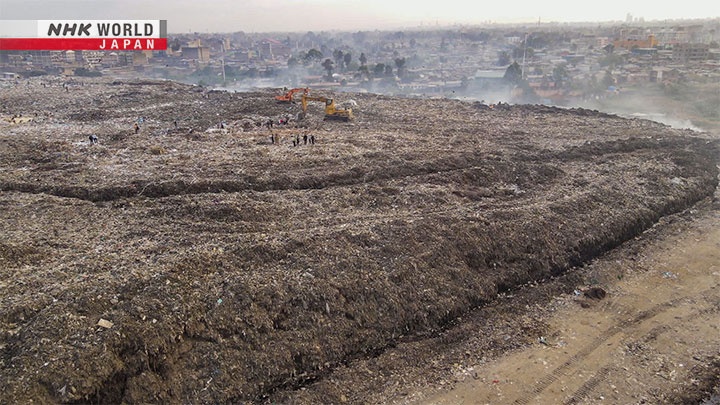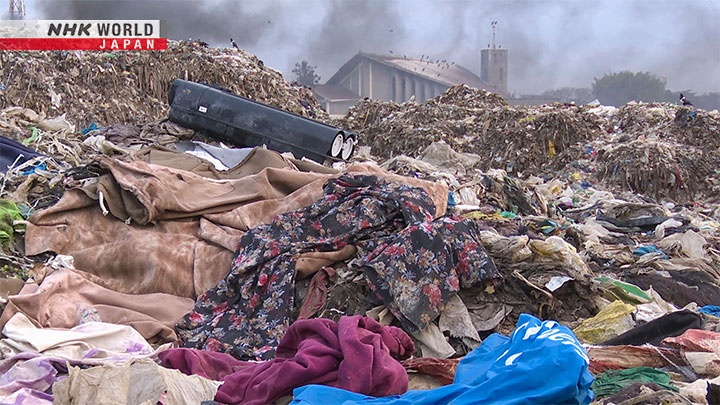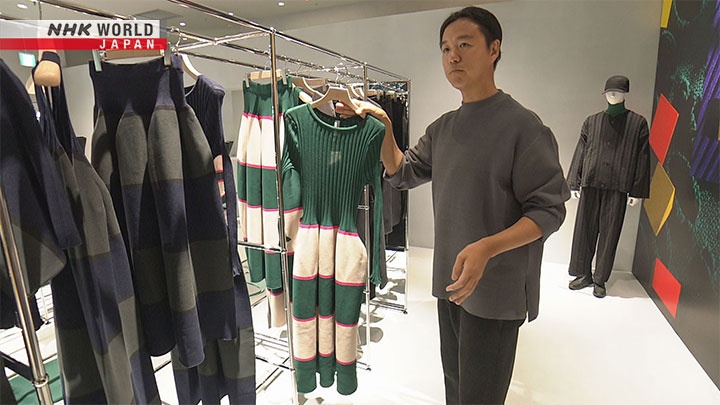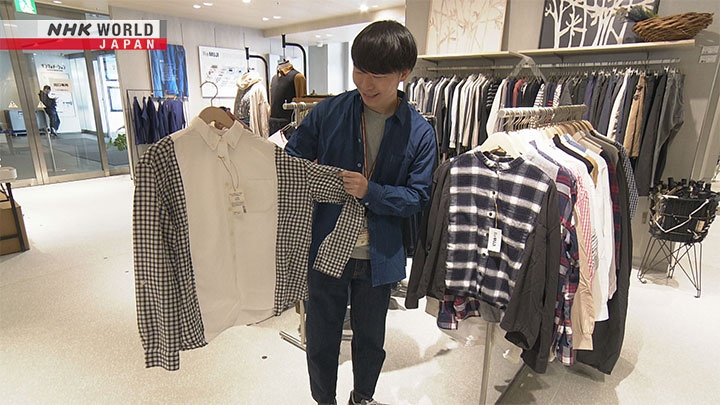Clothes can spark joy, but mass production has heavy environmental costs and clothing waste is a growing problem. Japanese designers and firms are taking up new projects to transform the industry.




Transcript
Kenya, East Africa.
Vast piles of trash cover an area equivalent to around 120 soccer fields.
Many contain huge amounts of clothing from all over the world.
With nowhere else to go, the clothes are left here to rot.
It is known by many as the graveyard of clothes.
One Japanese designer journeyed to the area.
International fashion designer Nakazato Yuima.
As someone who creates clothing for a living, seeing the sheer mass of waste was a shock.
Clothes here in Kenya are bright and colorful.
That means somebody chose those colors to make someone happy.
They wanted people to buy and wear those clothes.
Now those colors are just part of the mud.
It feels so painful to me.
Fashion can bring joy and inspire smiles.
But criticism of the clothing industry has grown louder in recent years.
The manufacture of clothes requires vast quantities of water and oil.
And much of that clothing ends up discarded.
To improve this situation, France has banned the destruction of unsold inventory.
The EU is expected to follow suit.
We're seeing major changes to the industry.
Mass production, mass consumption, mass profit. That era is coming to an end.
How do we move away from the high-volume production and waste business model?
What cycle will take its place?
We turn the spotlight towards several Japanese projects that are looking to shake up the global fashion industry.
Nakazato Yuima is the only Japanese designer currently presenting at the pinnacle of fashion, Haute Couture Week in Paris.
This is some of Nakazato's work.
He has created many highly original pieces, unbound by traditional philosophies of design.
He used cutting-edge technology to create the unique shape of this top.
Fabric made with artificial proteins is soaked in water to instantly create a shape fitted specifically to a particular wearer.
Nakazato has pursued what it means to create fashion to fit our ever-changing individual preferences and human nature.
His passion for clothing brought him to an unexpected turning point in 2022.
I'm in the trash heaps of Dandora, Kenya.
The smell is atrocious. I'm double masking, but it still stinks.
On a trip to Kenya to film a documentary, he encountered the mountains of clothing waste.
He says that the sight made him reconsider how he approached making clothes.
I asked myself, have I really been doing the right thing?
Isn't there anything more I can do?
I suppose I realized that I hadn't been doing nearly enough.
Kenya's markets receive secondhand clothes from the West, China, and around the world.
The country is one of the world's top buyers of used clothing.
As of 2019, annual imports had already topped 180,000 tons.
Used clothing is strung throughout this market.
Tailors and seamstresses can be found further within.
Any tears or stains are dealt with swiftly.
Look at it.
They waste little, piecing together different parts to create brand-new outfits.
Used clothing is a vital part of everyday life here.
Over the four years to 2019, used clothing imports grew by around 70%.
This has brought about some major challenges.
This woman largely buys secondhand clothes from China.
But she says that the quality has fallen sharply.
The bales that they are exporting are not good at all.
A lot of the items are of poor quality, and cannot be sold.
They are piled up in her warehouse.
So those are all rejects?
Yeah, this one are mine for yesterday.
You'll get something like this one.
These are finished.
Nobody wants to buy this.
You can get top, top, top of trouser, top, trouser like this one.
You cannot repair anymore.
The dandora dump site, these are for there.
As a result, the amount of clothes she's been forced to dump has grown over the last decade.
Piles of unusable rags cast away behind the market spill into the river.
More and more unsold, unusable clothes accumulate atop the mountains of trash.
No label on this dress. You can't tell where it's from.
These are "Made in China."
The trash mountains continue to grow each year,
causing serious problems in surrounding neighborhoods.
Land that was meant to be used for housing has been overwhelmed by the trash,
and fires burn across the landscape.
In the face of this reality brought about by vast quantities of clothing...
...Nakazato began questioning society's approach to making clothes.
For human beings to manufacture anything requires an extraordinary amount of energy.
Over the last few decades, economic reasoning has driven us to produce more and more,
in the name of making ourselves happier and more comfortable.
I think we, as humans, have an instinctive passion and drive for creation.
But what happens after something has been made?
I don't think that's a question we've really considered properly.
Clothes are a daily necessity for everyone.
So why has there been a sudden explosion in clothing waste?
One factor is a global increase in clothing production, led by the popularity of fast fashion.
Demand for clothing in Japan has not grown over the last 30 years -
rather, sales have fallen in major categories.
Yet the same period has seen supply increase by 80%.
Manufacturers are producing far more than what consumers are buying.
Unwanted clothes around the world are often donated or exported to developing countries.
Eventually, they end up in mountains of waste.
Worldwide, over 92 million tons of textiles are reported to be discarded every year.
Clothes already consume vast resources during their manufacture,
and produce large amounts of carbon dioxide.
Making a single T-shirt requires around 2,720 liters of water -
primarily to grow the cotton.
This is enough water to last one person nearly two and a half years.
The challenge we now face is finding a way to efficiently recycle used clothes into new resources.
We're seeing major changes to the industry.
The era of mass production, mass consumption and mass profit is coming to an end.
The business model of pursuing continual profit growth simply isn't sustainable.
We need to design a whole life cycle for clothes.
How can we as a society begin to address that?
The mountains of waste in Kenya were a massive shock for Nakazato.
He began to plan a new approach to draw attention to this major challenge.
He wondered whether it might be possible to make new clothes out of old ones.
People are just animals that require clothing.
So what should we make that clothing from?
Let's think about what our clothes are made from.
Could we not leverage used or unwanted clothes as another resource?
We could turn them back into new clothes for everyday wear.
It would create a large, very logical cycle.
As a concept, it makes a lot of sense to me.
Nakazato wanted to create a new life cycle for clothing.
It would mean turning no-longer-worn, discarded clothes not into trash,
but materials to make new clothes - a highly difficult undertaking.
Nakazato turned to a major company for help.
A Japanese manufacturer of printers and other precision electronics.
The firm has been supporting Nakazato's fashion shows since early 2022.
Their high-precision and eco-conscious digital printers create delicate patterns on his work.
Nakazato asked the manufacturer if it would be possible to make new fabric from old clothes.
It was a completely new field for the company.
Making fabric presented a potential new business opportunity.
The firm established a development team of around ten people, including engineers and marketers.
However, creating new garments out of old clothes proved no easy task.
Nakazato bought this in Africa. It's all secondhand clothing.
I think some of it is a polyester blend. This one is cotton-based.
There is technology in development to reduce clothes of a single material into fibers to be turned into new clothing.
If the fabric is a mixture of different materials, however, the technological boundaries become almost insurmountable.
But Nakazato saw hope in the company's paper recycling technology.
First, used paper is turned into fibers through mechanical force, using minimal water.
These are then hardened with adhesive to make new paper.
Could a similar approach work with fabric?
It felt like a call to arms.
This is something only we can do.
So of course we have to do it. It's our duty.
After much trial and error, the team created a non-woven fabric.
They take old clothes, disentangle their webs of fibers,
and bond them using a process of their own discovery.
Non-woven fabric has long been considered unsuitable for clothing,
as it lacks the interlacing warp and weft of woven cloth.
The team spent six months looking for ways to improve the output into potential clothing fabric.
It feels sturdy. Reassuring.
Last time I rubbed it like this, it tore pretty quickly.
What happens if it gets wet? Like laundry.
We're a way off from laundry.
We'd need to run tests with washing machines.
Rubbing against other clothes, wringing it out.
- It'll get stiffer as it gets thicker?
- It will, yeah.
Do you want something thinner?
Something that can be made softer, yes.
Two weeks later, what has the development team produced?
They've begun printing black pigmented ink on the non-woven fabric.
This has made the fabric stronger, allowing for a thinner cloth that also has a touch of luxury.
The ink adds depth to the fabric.
And gives it a bit of an interesting texture.
Nakazato has designed clothes from the non-woven fabric, and they've begun to take shape.
His collection will be shown in Paris in two weeks' time.
He wants to showcase the fabric while it's still in the development stage.
I think it's a little stiff as a texture, which does make it look a bit uncomfortable to wear.
The key will be to soften it up and make it easier to wear as clothing.
Nakazato wants to draw people's attention to the issue of discarded clothing.
So he's printed photos of Kenya's graveyard of clothes onto the non-woven fabric,
turning it into a reddish pattern.
When I added the red tint, it made the whole piece look floral.
Almost like a scene from a natural landscape.
A simple color change can add a lot of abstraction.
In some ways, perhaps I'm asking the question, "What exactly 'is' trash?"
It's something we produce, but if we can alter its value, it could become a resource.
It could create something beautiful.
That's what I'm hoping to achieve.
Nakazato's collection takes to the runway in Paris.
The pieces created from secondhand Kenyan clothes cause a stir.
A couple of weeks on from his Paris show.
Nakazato is still ruminating on those towering mountains of discarded clothes.
Have I been able to make those mountains a little smaller yet?
Sadly, the answer right now is no.
I still feel powerless.
I keep thinking...
Is there nothing that my skillset can help me do?
How can we minimize fabric waste and alleviate the environmental toll?
Global brands are looking at all kinds of approaches to recycling clothes into resources.
Fast fashion brands are also selling products made from upcycled fabric.
This pair of sneakers is made from a single material, without any additional parts that could impair the recycling process.
Everything from the soles to the laces is recyclable.
Some Japanese companies have also begun efforts to prevent clothing waste and recycle more.
This major manufacturer and retailer has over a thousand stores worldwide.
It sells clothes and household items.
These are redyed clothes.
Items collected from our customers have been dyed indigo blue and black.
We then sell them in our stores.
Some might look a solid blue, but if you look closely,
you'll see that they have retained a faint shadow of the original pattern underneath.
I believe this was originally a plaid shirt.
It adds a bit of an interesting flavor, I think.
This one here was made from two different shirts.
Parts of the original pieces were no longer viable.
But they can be remade like this to create a wearable shirt.
All of these items were made from clothes collected at stores.
They came from customers who no longer needed them.
All of the Japanese stores have boxes for collecting the firm's own clothes.
Take this sweater, for example.
There are no pills and it could still be worn.
It's pristine.
It's still quite wearable.
At first, the collected clothes were recycled into biofuel.
But so many of the items were still wearable, inspiring the firm to begin restoring them for sale.
They're made into entirely new items of clothing.
There is a very long tradition of taking great care of fabrics in Japan.
Stained clothes would often be redyed, or refashioned.
They might be embroidered to improve their longevity, or sewn into something new.
This culture is one thing that inspired us to take this new path.
The company is encouraging people to use their clothes for as long as possible, instead of throwing them away.
Environmental awareness is growing in the clothing industry.
One up-and-coming brand is garnering attention for its combination of eco-conscious ethics and design.
Established three years ago...
...it was the first Japanese clothing brand
to obtain a strict international certification for its high standards of social and environmental performance.
Almost all of its products are knitted fabrics.
The brand is the brainchild of creative director Takahashi Yusuke.
He stripped out any waste from the manufacturing process.
The armholes of this dress aren't sewn in.
The knit is programmed to create the entire garment in one.
It's the same at the waist.
There's no sewing involved.
It's knitted all the way down.
This requires no cutting and produces no scraps during the manufacturing process.
Blouses are usually made by cutting around a stencil.
This produces scrap cloth that becomes waste.
These scraps can make up around 15% of the entire fabric used for the clothing.
Takahashi uses computerized 3D knitting techniques for his manufacturing.
The pieces are knitted using a similar technique to a 3D printer,
making it possible to mass produce a diverse range of designs.
From jackets to dresses, the brand is almost entirely focused on knitted items.
Their manufacturing produces practically no excess or waste.
The main resource for the clothes is recycled polyester made from discarded plastic bottles.
Using upcycled materials means no new petroleum is needed for production.
It's an approximate 70% reduction in greenhouse gas emissions.
The company calculates the emissions created by an item of clothing, from its manufacture through to its disposal.
This dress was made with just around 14% of the emissions produced by a typical piece of clothing.
The brand is the first from Japan's fashion industry to publicly disclose these figures.
It also produces all of its products domestically, minimizing the need for shipping.
Meanwhile, Takahashi is working to help contracted factories understand the importance of this approach,
and some are already using renewable energy.
The clothing industry is enormous.
Changes at a single company don't really move the needle.
The question is whether or not the entire supply chain can be improved.
The brand's clothes also receive high acclaim for their design.
By producing attractive clothing, Takahashi's firm is raising awareness,
and shaping a new future for people to aspire to.
I truly believe that we can change society through clothing.
I hope that we can become a brand, a firm that takes action.
What we do would be entirely meaningless if we made no impact on society.
Fashion designer Nakazato is still determined
to create a new resource cycle by making clothes from secondhand items in Kenya.
He has invited the team from the precision manufacturer to join him on a visit to the country.
The first step is to actually go there.
I really believe there's so much to be learned by actually seeing the situation on the ground, facing the reality.
It certainly had a profound effect on me.
I think it would have a similar effect on the team if they were to visit in person and experience it for themselves.
Nakazato explains his motivations to the company's development team.
One key factor is how your technology could change the future.
It's an enormous opportunity for research going forward.
What and how can we contribute if we bring our technology over?
Would business be feasible there?
The company is considering the business potential of recycling old clothes.
It's late July.
Nakazato and the development team arrive in Kenya.
They're joined by an executive officer and a general manager
looking to sound out the possibility of upcycling secondhand clothes in Kenya.
It's a chance to look for ourselves.
It will give us accurate information about the situation here.
They start with the infamous graveyard of clothes.
It's the place Nakazato most wanted to show them.
There are a lot of clothes.
You can see them everywhere.
- This is where everything ends up.
- Is that right?
I'm shaken.
I had no idea it was like this.
Worse than I ever imagined.
We need to act earlier.
The clothes here are dusty, dirty, filthy. Tough to recycle.
It's not really about what one firm can do.
We need to get involved before they end up here.
Once they're here, it's almost impossible to save them.
Can they help save the old clothes that arrive in Kenya before they end up as trash?
Nakazato's group visits a government facility that researches the use of waste products.
They bring samples of their recycled non-woven fabric to discuss using it to make products in Kenya.
But their hopes are dealt a blow.
It is actually quite a brilliant and good product as I can see.
If the volume, I mean the size can be a little bit thick,
I think our, our grazing animals as well can be very comfortable using this.
Have you ever considered about the vehicle?
It is easy to use for the cars or architectures or, you know, floormats or...
That could be possible.
But actually, this is the same method as before.
But we would like to change the situation.
So the waste of the clothing becoming the value going up.
That is upcycling, not recycling, but should be upcycling.
It seems their textile has a way to go before it can be accepted in the same light as more traditional fabrics.
This local textile manufacturer is one of Kenya's most environmentally conscious companies.
It produces rain-fed cotton with a focus on traceability.
The team wants to know whether it would be possible to establish a successful business in Kenya.
Would you like to know about any possibilities of a market doing this kind of business?
This is a very exciting project for me.
There's interest, but they're also given a friendly warning.
Is there a big demand for this?
Let me tell you, it is more expensive to do recycled garments.
Virgin fibers are cheaper than recycled fibers.
Society is not conscious about circularity,
circular economy, not as conscious as European market.
The advice is to focus on the global market,
even if they do manage to upcycle old clothes in Kenya.
I think our samples need to be a bit more refined.
They need to be able to promise added value.
And I think we still have plenty of work ahead of us improving the technology to allow for this.
What do they need to push the plan forward?
Nakazato believes that creating clothes that people actually want to wear will be crucial.
Would you wear this tomorrow?
Honestly, I think most people would say no.
And I understand that overcoming this fact is not going to be an easy task.
It really is...a very tricky problem.
I suppose the question is, how serious are we?
Two days before returning to Japan, they visit a group of young people learning to sew.
I'm nervous. The most nervous I've been on this trip.
The facility is for girls who for various reasons are unable to live with their parents.
To provide them with a living after they leave, the girls are taught how to sew.
International designer Nakazato has been asked to come and give a talk.
Wow. Thank you. It's nice, this is also nice.
Nakazato talks about his own experiences as a delicate, shy child.
When I wear something very nice clothes and I went to the school, I became suddenly popular in the class.
I wear something nice, like, people recognize, "Ah, you are wearing very nice."
And I was very happy.
So, I could feel fashion has a power.
And if I wear something, you know, favorite clothes,
you can be, you can connect with social, you can connect with the friends.
I realized the power of fashion design.
Because people make, it is able to, you know, make happy.
A dress made from upcycled secondhand clothes from Kenya.
This jacket is made by old second-hand clothes.
Maybe could you wear, somebody?
Could you wear this one?
Thank you.
I am next!
The unwanted, discarded clothes take on a new sparkle as the girls try them on.
Cat walk!!!
"Polepole."
They all had such a sparkle in their eyes, wearing the clothes.
It was wonderful to see them all smiling like that.
It really means a great deal to me.
Two months after their return from Kenya.
The development team has been improving the non-woven fabric made from old clothes.
They've created their thinnest and most supple fabric yet.
- It's a lot thinner than before.
- It really is. Yes.
Looks good.
- The printed pattern looks good too.
- Yes.
We wanted to push the boat out a bit.
To see how far we could go.
I think this is our first sample that's really pushed our limits.
I want to keep pushing!
Nakazato continues to walk a difficult path that many have already given up on.
He's hard at work on new designs for the improved fabric,
reinvigorating discarded items into glamorous garments that spark joy.
Nakazato is chasing a dream to transform our relationship with clothes.
Who made your clothing?
Where was it made?
What is it made of, and where will it go when you're done with it?
And, of course, how will it return?
We need to make this kind of information traceable and visible.
This will help raise awareness and forge connections between people and the clothes they wear.
I believe in the potential of this project, and I'll keep working on it.
What kind of clothes do you want to wear?
What will be your relationship with those clothes?
Japanese designers and companies are pursuing social change through clothes manufacturing.
Their efforts to weave a new cycle of sustainable consumption are beginning to take shape.